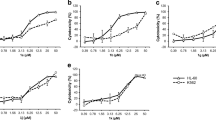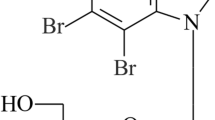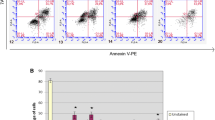Abstract
Purpose. We studied the antitumor activity of 2-amino-4,4α-dihydro-4α,7-dimethyl-3H-phenoxazine-3-one (Phx), which was synthesized by the reactions of 2-amino-5-methylphenol with bovine hemoglobin, on human B cell lymphoblastoid cell lines, P3HR-1 and Raji derived from African Burkitt's lymphoma, and the human T cell lymphoblastoid cell line Molt-4. We also studied whether Phx might cause apoptosis and necrosis in these cells.
Methods. We evaluated cell viability and apoptosis and necrosis of the cells in the presence of Phx, by using agarose gel electrophoresis, flow cytometry, and fluorescence microscopy.
Results. Phx suppressed the viability of P3HR-1, Raji, and Molt-4 cells, though the suppression patterns were different, i.e., Phx suppressed the viability of P3HR-1, Raji, and Molt-4 cells at higher concentrations, while the drug enhanced the viability of Raji cells, but not those of P3HR-1 and Molt-4 cells at lower concentrations. To investigate which type of cell death – apoptosis or necrosis – is induced by Phx, induction of DNA ladder, phosphatidylserine externalization, and propidium iodide-permeable cells were examined in Phx-treated cells. Although Phx did not induce DNA ladder formation, it induced the phosphatidylserine externalization and propidium iodide-permeable cells, suggesting that Phx caused a mixed type of cell death, both apoptosis and necrosis. The population of early stage apoptotic cells was dominant in Raji cells, and that of the late stage apoptotic/necrotic cells was dominant in Molt-4 cells after 72-h treatment with Phx. The population of the early stage apoptotic cells and the late stage apoptotic/necrotic cells was almost equal in P3HR-1 cells in the presence of Phx, though the population of both types of cells increased with time. The nuclear morphological analysis of Phx-treated Raji, P3HR-1, and Molt-4 cells also showed that Phx induces apoptosis.
Conclusions. The present results suggest that Phx shows antitumor activity against human B cell-derived and T cell-derived lymphoblastoid cell lines, in vitro, causing apoptosis and necrosis.
Similar content being viewed by others
Author information
Authors and Affiliations
Additional information
Electronic Publication
Rights and permissions
About this article
Cite this article
Koshibu-Koizumi, .J., Akazawa, .M., Iwamoto, .T. et al. Antitumor activity of a phenoxazine compound, 2-amino-4,4α-dihydro-4α,7-dimethyl-3H-phenoxazine-3-one against human B cell and T cell lymphoblastoid cell lines: induction of mixed types of cell death, apoptosis, and necrosis. J Cancer Res Clin Oncol 128, 363–368 (2002). https://doi.org/10.1007/s00432-002-0352-3
Received:
Accepted:
Issue Date:
DOI: https://doi.org/10.1007/s00432-002-0352-3




